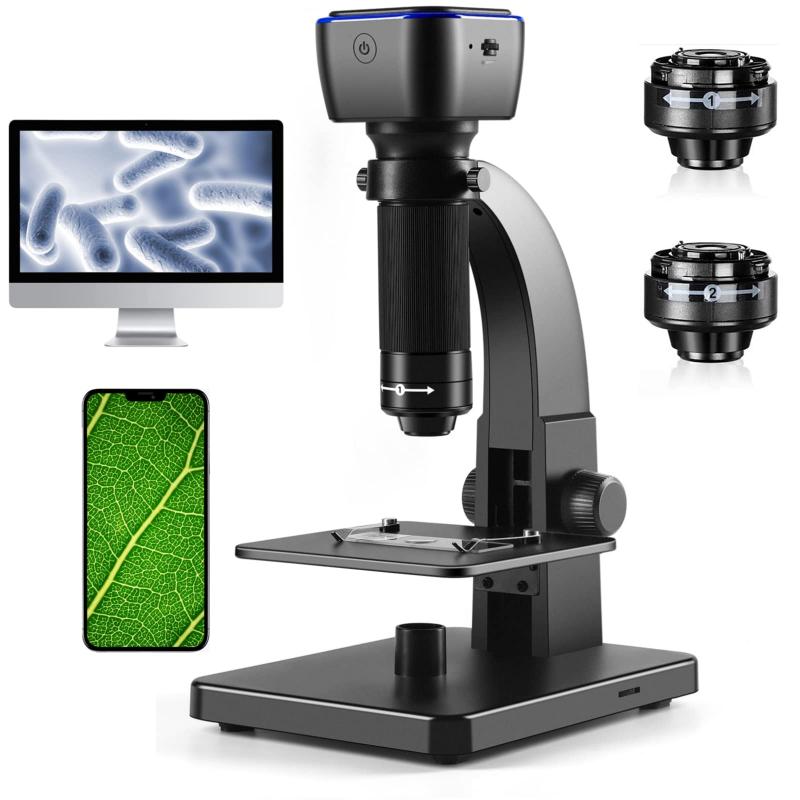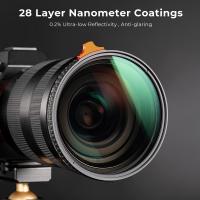What Can An Electron Microscope See ?
An electron microscope can see objects at a much higher resolution compared to a light microscope. It can visualize the fine details of a sample, such as the structure of cells, tissues, and even individual atoms.
1、 Atomic Structure: Visualizing individual atoms and their arrangements.
An electron microscope is a powerful tool that can visualize objects at a much higher resolution than traditional light microscopes. It uses a beam of electrons instead of light to create an image, allowing for the observation of structures at the atomic level.
One of the main capabilities of an electron microscope is the ability to see individual atoms and their arrangements. With its high magnification and resolution, it can reveal the intricate details of atomic structures. This is particularly useful in the field of materials science, where understanding the arrangement of atoms is crucial for developing new materials with specific properties.
The latest advancements in electron microscopy, such as aberration correction and high-resolution imaging techniques, have pushed the boundaries of what can be seen. Scientists can now visualize individual atoms in three dimensions, allowing for a deeper understanding of atomic arrangements and their impact on material properties.
Furthermore, electron microscopes can also provide information about the chemical composition of a sample. By using energy-dispersive X-ray spectroscopy (EDS), researchers can analyze the X-rays emitted by the sample when it is bombarded with electrons. This technique allows for the identification of different elements present in the sample, providing valuable insights into its composition.
In summary, an electron microscope can see atomic structures, visualizing individual atoms and their arrangements. With the latest advancements in electron microscopy, scientists can now observe atoms in three dimensions and analyze the chemical composition of samples. This capability has revolutionized our understanding of materials and has opened up new possibilities for designing and developing advanced materials with tailored properties.

2、 Nanoscale Imaging: Examining nanoscale structures and materials.
An electron microscope is a powerful tool that can provide detailed imaging of nanoscale structures and materials. It uses a beam of electrons instead of light to magnify and visualize objects at a much higher resolution than traditional light microscopes.
With an electron microscope, scientists can observe and analyze a wide range of nanoscale phenomena. It can reveal the intricate details of biological samples, such as cells, tissues, and organelles, allowing researchers to study their structure and function at the nanoscale level. This has been crucial in advancing our understanding of various biological processes and diseases.
In addition to biological samples, electron microscopes can also be used to examine nanoscale materials, such as nanoparticles, nanowires, and thin films. By imaging these materials, scientists can gain insights into their composition, morphology, and surface properties. This information is vital for developing new materials with enhanced properties for applications in fields like electronics, energy storage, and medicine.
Moreover, electron microscopes can be equipped with various analytical techniques to provide even more detailed information. For example, energy-dispersive X-ray spectroscopy (EDS) can be used to determine the elemental composition of a sample, while electron energy loss spectroscopy (EELS) can provide information about the electronic structure and chemical bonding.
The latest advancements in electron microscopy have further expanded its capabilities. For instance, aberration-corrected electron microscopy has significantly improved the resolution and image quality, allowing scientists to visualize individual atoms and atomic-scale defects. This has opened up new possibilities for studying materials at the atomic level and designing novel materials with tailored properties.
In summary, an electron microscope can see nanoscale structures and materials, enabling scientists to explore and understand the world at an incredibly small scale. Its applications range from biological research to materials science, and the latest advancements continue to push the boundaries of what can be observed and analyzed at the nanoscale.

3、 Cell Ultrastructure: Revealing detailed cellular components and organelles.
An electron microscope is a powerful tool that can reveal the intricate details of cellular components and organelles, allowing scientists to study the cell ultrastructure. Unlike light microscopes, which use visible light to magnify objects, electron microscopes use a beam of electrons to achieve much higher resolution.
With an electron microscope, scientists can observe and analyze the fine structures within cells that are not visible with a light microscope. This includes the detailed morphology of organelles such as the nucleus, mitochondria, endoplasmic reticulum, Golgi apparatus, and lysosomes. It can also reveal the arrangement and organization of cellular components, such as the cytoskeleton and microtubules.
Furthermore, electron microscopy can provide insights into cellular processes and interactions. For example, it can visualize the formation of vesicles during endocytosis or exocytosis, the intricate network of synaptic connections in the brain, or the structural changes that occur during cell division.
In recent years, advancements in electron microscopy techniques have further expanded its capabilities. Cryo-electron microscopy, for instance, allows scientists to study biological samples in their native, frozen state, providing high-resolution images of proteins and macromolecular complexes. This has revolutionized the field of structural biology, enabling the determination of atomic-level structures of biomolecules.
Overall, electron microscopy has become an indispensable tool in cell biology, providing invaluable insights into the ultrastructure of cells and helping scientists unravel the complex machinery that drives cellular processes.

4、 Material Analysis: Investigating the composition and properties of materials.
An electron microscope is a powerful tool used in material analysis to investigate the composition and properties of various materials. It can provide detailed information about the structure and characteristics of a wide range of samples, from biological specimens to nanomaterials.
One of the primary capabilities of an electron microscope is its ability to achieve extremely high magnification. Unlike optical microscopes, which use visible light, electron microscopes use a beam of electrons to illuminate the sample. This allows for much higher resolution, enabling scientists to see objects at the nanoscale level. With modern electron microscopes, it is possible to achieve magnifications of up to several million times, revealing intricate details that would otherwise be invisible.
In addition to high magnification, electron microscopes also offer other imaging techniques that provide valuable information about the composition and properties of materials. For example, energy-dispersive X-ray spectroscopy (EDS) can be used to analyze the elemental composition of a sample. By detecting the characteristic X-rays emitted by the sample when it is bombarded with electrons, EDS can identify the elements present and determine their relative abundance.
Furthermore, electron microscopes can also be equipped with other analytical techniques such as electron diffraction and electron energy-loss spectroscopy (EELS). Electron diffraction can be used to determine the crystal structure of a material, providing insights into its atomic arrangement. EELS, on the other hand, can provide information about the electronic structure and chemical bonding within a sample.
The latest advancements in electron microscopy have further expanded its capabilities. For instance, aberration-corrected electron microscopy has significantly improved the resolution and image quality, allowing for even more precise analysis of materials. Moreover, in-situ electron microscopy techniques now enable researchers to observe dynamic processes in real-time, providing valuable insights into the behavior of materials under different conditions.
In summary, an electron microscope can see and analyze a wide range of materials, providing detailed information about their composition and properties. With its high magnification, advanced imaging techniques, and recent technological advancements, electron microscopy continues to be an indispensable tool in material analysis.







































